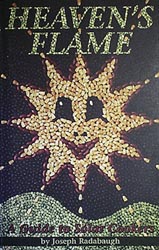a history of solar cooking
this article is excerpted from the book heaven's flame, by joe radabaugh .
it can be ordered here.
.
it can be ordered here.
for most of human existence, the cooking of food was unknown. people ate food in the condition in which they found it. then humans found that fire could be controlled and used to cook food. fire is essentially solar power stored in the form of wood. if we look at it this way, solar was the first method of cooking on earth.
looking for the beginnings of what we now call solar cooking, we find some isolated stories in the distant past. the essenes, an early sect of jews, gently heated wafers of ground sprouted grains on rocks heated by the desert sun. this was not cooking in the contemporary sense. the goal was not to overheat the wafers, but to heat them only to the point which did not kill the living enzymes in the grains. this created a food source that is extremely healthy for the human body.
the first known person to build a box to solar cook food was horase de saussure, a swiss naturalist. he cooked fruits in a primitive solar box cooker that reached temperatures of 190�f. he was the grandfather of solar cooking.
during this time, others also started using solar cookers. in india, a british soldier patented a fairly sophisticated solar cooker that looked a lot like the solar chef, which is described later in this book. in 1894, there was a restaurant in china that served solar cooked food. there are also stories about an early sea captain who created a solar cooker he could use on long voyages.
cookers we see today started evolving in the 1950's. our world was still reeling from the insanity of war. people were looking for ways to create a stable and peaceful future. the worldwide nature of the previous war showed, in some ways for the first time, that we are a world community facing global problems that affect us all.
one of these global problems was the growth of deserts around arid communities. the united nations and other major funding agencies initiated many studies to design solar cookers that could alleviate some of the reliance on plant life for fuel. many top engineers of the 1950's were hired to study different aspects of solar cooking designs. these studies concluded that properly constructed solar cookers not only cooked food thoroughly and nutritiously, but were quite easy to make and use.
the un then sponsored studies and programs to introduce these cookers into cultures where the need was most apparent. these efforts proved mostly unsuccessful. in one study, 500 wooden solar cookers were given to a refugee camp. three months later they had been chopped up and used for firewood. the social scientist concluded that traditional cooking methods were too culturally ingrained, and people were unwilling to adapt.
the un did note one success. in a northern mexican community lacking fuelwood, they found that the cookers were still in use five years later. this showed that it was possible to get cookers out to people in need.
the un, in spite of this one success, concluded that solar cookers were not a viable option and all funding for solar cookers stopped.
many involved with this early effort concluded that the studies themselves were flawed. they felt the designs being promoted were too complicated. also, the cookers were too expensive for the intended users. they felt that more work was needed on the cooker designs. a few of them kept the potential of solar cookers alive by continuing to develop them in their own sunny backyards.
others felt that the promotion techniques used in the un studies were also flawed. social scientists, who had never integrated solar cooking into their own lives, were in charge of the un studies. the cookers were promoted as a solution to poor people's problems, but certainly not as cooking tools that would be useful in developed countries. this caused solar cookers to be looked upon as a second class tool by those being asked to use them. solar cooks sought new ways to promote solar cookers that were more sensitive to the cultures they were trying to share them with.
this is the history we are now writing. gone is much of the heavy engineering in favor of backyard hobbiests building their own simple cookers. gone are the paternalistic promoters telling people what they need to use. instead, people are sharing a tool that they themselves enjoy using. this is a great maturation within the solar cooking movement. it is also the reason we are now on the verge of a new growth cycle. the future story of solar cooking is wide open.